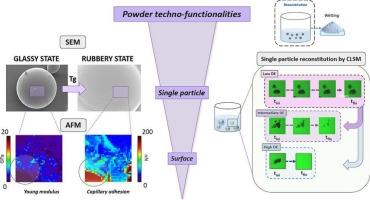Links between single maltodextrin particles properties and powder functionality
IF 12.5
1区 化学
Q1 CHEMISTRY, APPLIED
引用次数: 0
Abstract
Maltodextrins are extensively used in the food industry to shape the physicochemical properties of food products. This multiscale study investigates three different Dextrose Equivalent (DE) maltodextrins as model matrices to elucidate the relationship between techno-functional behaviors and single particle surface properties. It was evidenced that environmental variations and glass transition influence single particle properties, significantly impacting the powder bulk behavior. Utilizing Confocal Laser Scanning Microscopy (CLSM) and environmental Atomic Force Microscopy (AFM) at the single particle level, correlations between the wetting and nanomechanical properties of all maltodextrins were provided. It was revealed that wetting properties are directly DE dependent, as higher DE maltodextrins had shorter wetting times. Moreover, glass transition plays a critical role in determining surface elasticity and capillary adhesion, as it alters both physicochemical properties and particle morphology. Indeed, a decrease of the Young modulus with Relative Humidity (RH) and glass transition correlated with the increase of capillary forces. This was corroborated by Scanning Electron Microscopy (SEM) and Specific Surface Area (SSA) measurements at different RH. These findings confirmed that glass transition drives particle morphology, with global surface smoothing and swelling occurring in the rubbery state.

单个麦芽糖糊精颗粒特性与粉末功能之间的联系
麦芽糊精在食品工业中被广泛用于塑造食品的物理化学特性。本多尺度研究以三种不同的葡萄糖当量(DE)麦芽糊精为模型矩阵,以阐明技术功能行为与单颗粒表面性质之间的关系。结果表明,环境变化和玻璃化转变影响了单颗粒的性能,显著影响了粉末的体积行为。利用共聚焦激光扫描显微镜(CLSM)和环境原子力显微镜(AFM)在单颗粒水平上研究了所有麦芽糊精的润湿和纳米力学性能之间的相关性。结果表明,麦芽糊精的润湿性能与DE直接相关,因为高DE的麦芽糊精润湿时间较短。此外,玻璃化转变在决定表面弹性和毛细附着力方面起着关键作用,因为它改变了物理化学性质和颗粒形态。杨氏模量随相对湿度(RH)和玻璃化转变的降低与毛细力的增加有关。不同相对湿度下的扫描电子显微镜(SEM)和比表面积(SSA)测量证实了这一点。这些发现证实了玻璃化转变驱动颗粒形态,在橡胶状态下发生整体表面平滑和膨胀。
本文章由计算机程序翻译,如有差异,请以英文原文为准。
求助全文
约1分钟内获得全文
求助全文
来源期刊

Carbohydrate Polymers
化学-高分子科学
CiteScore
22.40
自引率
8.00%
发文量
1286
审稿时长
47 days
期刊介绍:
Carbohydrate Polymers stands as a prominent journal in the glycoscience field, dedicated to exploring and harnessing the potential of polysaccharides with applications spanning bioenergy, bioplastics, biomaterials, biorefining, chemistry, drug delivery, food, health, nanotechnology, packaging, paper, pharmaceuticals, medicine, oil recovery, textiles, tissue engineering, wood, and various aspects of glycoscience.
The journal emphasizes the central role of well-characterized carbohydrate polymers, highlighting their significance as the primary focus rather than a peripheral topic. Each paper must prominently feature at least one named carbohydrate polymer, evident in both citation and title, with a commitment to innovative research that advances scientific knowledge.
 求助内容:
求助内容: 应助结果提醒方式:
应助结果提醒方式:


